Ruichuan An
DataFlow: An LLM-Driven Framework for Unified Data Preparation and Workflow Automation in the Era of Data-Centric AI
Dec 18, 2025Abstract:The rapidly growing demand for high-quality data in Large Language Models (LLMs) has intensified the need for scalable, reliable, and semantically rich data preparation pipelines. However, current practices remain dominated by ad-hoc scripts and loosely specified workflows, which lack principled abstractions, hinder reproducibility, and offer limited support for model-in-the-loop data generation. To address these challenges, we present DataFlow, a unified and extensible LLM-driven data preparation framework. DataFlow is designed with system-level abstractions that enable modular, reusable, and composable data transformations, and provides a PyTorch-style pipeline construction API for building debuggable and optimizable dataflows. The framework consists of nearly 200 reusable operators and six domain-general pipelines spanning text, mathematical reasoning, code, Text-to-SQL, agentic RAG, and large-scale knowledge extraction. To further improve usability, we introduce DataFlow-Agent, which automatically translates natural-language specifications into executable pipelines via operator synthesis, pipeline planning, and iterative verification. Across six representative use cases, DataFlow consistently improves downstream LLM performance. Our math, code, and text pipelines outperform curated human datasets and specialized synthetic baselines, achieving up to +3\% execution accuracy in Text-to-SQL over SynSQL, +7\% average improvements on code benchmarks, and 1--3 point gains on MATH, GSM8K, and AIME. Moreover, a unified 10K-sample dataset produced by DataFlow enables base models to surpass counterparts trained on 1M Infinity-Instruct data. These results demonstrate that DataFlow provides a practical and high-performance substrate for reliable, reproducible, and scalable LLM data preparation, and establishes a system-level foundation for future data-centric AI development.
GRAN-TED: Generating Robust, Aligned, and Nuanced Text Embedding for Diffusion Models
Dec 17, 2025Abstract:The text encoder is a critical component of text-to-image and text-to-video diffusion models, fundamentally determining the semantic fidelity of the generated content. However, its development has been hindered by two major challenges: the lack of an efficient evaluation framework that reliably predicts downstream generation performance, and the difficulty of effectively adapting pretrained language models for visual synthesis. To address these issues, we introduce GRAN-TED, a paradigm to Generate Robust, Aligned, and Nuanced Text Embeddings for Diffusion models. Our contribution is twofold. First, we propose TED-6K, a novel text-only benchmark that enables efficient and robust assessment of an encoder's representational quality without requiring costly end-to-end model training. We demonstrate that performance on TED-6K, standardized via a lightweight, unified adapter, strongly correlates with an encoder's effectiveness in downstream generation tasks. Second, guided by this validated framework, we develop a superior text encoder using a novel two-stage training paradigm. This process involves an initial fine-tuning stage on a Multimodal Large Language Model for better visual representation, followed by a layer-wise weighting method to extract more nuanced and potent text features. Our experiments show that the resulting GRAN-TED encoder not only achieves state-of-the-art performance on TED-6K but also leads to demonstrable performance gains in text-to-image and text-to-video generation. Our code is available at the following link: https://anonymous.4open.science/r/GRAN-TED-4FCC/.
Are Video Models Ready as Zero-Shot Reasoners? An Empirical Study with the MME-CoF Benchmark
Oct 30, 2025Abstract:Recent video generation models can produce high-fidelity, temporally coherent videos, indicating that they may encode substantial world knowledge. Beyond realistic synthesis, they also exhibit emerging behaviors indicative of visual perception, modeling, and manipulation. Yet, an important question still remains: Are video models ready to serve as zero-shot reasoners in challenging visual reasoning scenarios? In this work, we conduct an empirical study to comprehensively investigate this question, focusing on the leading and popular Veo-3. We evaluate its reasoning behavior across 12 dimensions, including spatial, geometric, physical, temporal, and embodied logic, systematically characterizing both its strengths and failure modes. To standardize this study, we curate the evaluation data into MME-CoF, a compact benchmark that enables in-depth and thorough assessment of Chain-of-Frame (CoF) reasoning. Our findings reveal that while current video models demonstrate promising reasoning patterns on short-horizon spatial coherence, fine-grained grounding, and locally consistent dynamics, they remain limited in long-horizon causal reasoning, strict geometric constraints, and abstract logic. Overall, they are not yet reliable as standalone zero-shot reasoners, but exhibit encouraging signs as complementary visual engines alongside dedicated reasoning models. Project page: https://video-cof.github.io
Jarvis: Towards Personalized AI Assistant via Personal KV-Cache Retrieval
Oct 26, 2025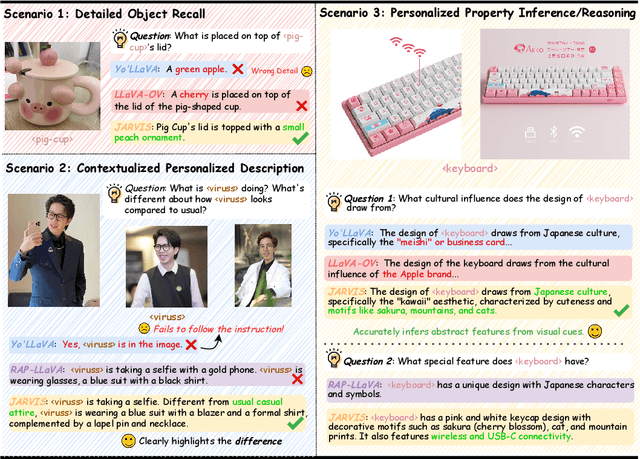

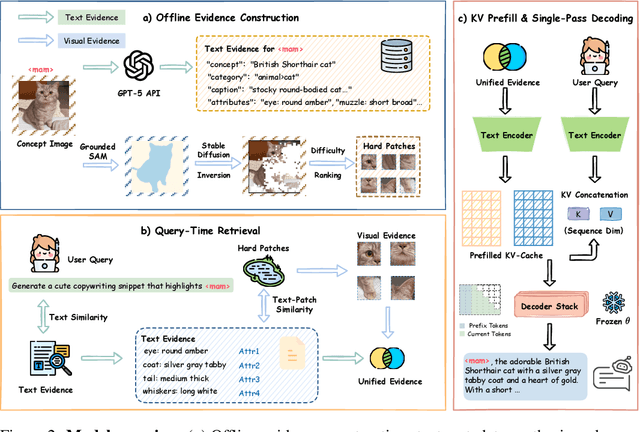

Abstract:The rapid development of Vision-language models (VLMs) enables open-ended perception and reasoning. Recent works have started to investigate how to adapt general-purpose VLMs into personalized assistants. Even commercial models such as ChatGPT now support model personalization by incorporating user-specific information. However, existing methods either learn a set of concept tokens or train a VLM to utilize user-specific information. However, both pipelines struggle to generate accurate answers as personalized assistants. We introduce Jarvis, an innovative framework for a personalized AI assistant through personal KV-Cache retrieval, which stores user-specific information in the KV-Caches of both textual and visual tokens. The textual tokens are created by summarizing user information into metadata, while the visual tokens are produced by extracting distinct image patches from the user's images. When answering a question, Jarvis first retrieves related KV-Caches from personal storage and uses them to ensure accuracy in responses. We also introduce a fine-grained benchmark built with the same distinct image patch mining pipeline, emphasizing accurate question answering based on fine-grained user-specific information. Jarvis is capable of providing more accurate responses, particularly when they depend on specific local details. Jarvis achieves state-of-the-art results in both visual question answering and text-only tasks across multiple datasets, indicating a practical path toward personalized AI assistants. The code and dataset will be released.
MorphoBench: A Benchmark with Difficulty Adaptive to Model Reasoning
Oct 16, 2025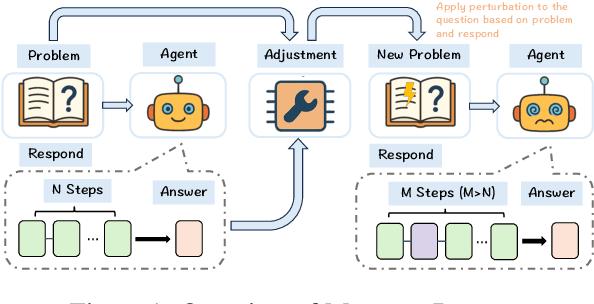

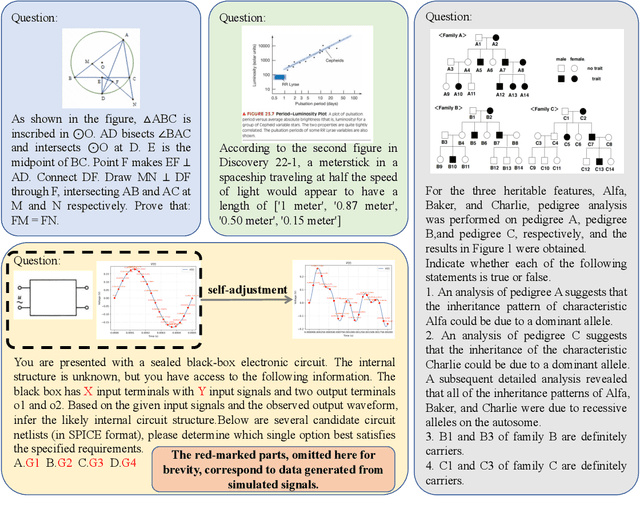

Abstract:With the advancement of powerful large-scale reasoning models, effectively evaluating the reasoning capabilities of these models has become increasingly important. However, existing benchmarks designed to assess the reasoning abilities of large models tend to be limited in scope and lack the flexibility to adapt their difficulty according to the evolving reasoning capacities of the models. To address this, we propose MorphoBench, a benchmark that incorporates multidisciplinary questions to evaluate the reasoning capabilities of large models and can adjust and update question difficulty based on the reasoning abilities of advanced models. Specifically, we curate the benchmark by selecting and collecting complex reasoning questions from existing benchmarks and sources such as Olympiad-level competitions. Additionally, MorphoBench adaptively modifies the analytical challenge of questions by leveraging key statements generated during the model's reasoning process. Furthermore, it includes questions generated using simulation software, enabling dynamic adjustment of benchmark difficulty with minimal resource consumption. We have gathered over 1,300 test questions and iteratively adjusted the difficulty of MorphoBench based on the reasoning capabilities of models such as o3 and GPT-5. MorphoBench enhances the comprehensiveness and validity of model reasoning evaluation, providing reliable guidance for improving both the reasoning abilities and scientific robustness of large models. The code has been released in https://github.com/OpenDCAI/MorphoBench.
WoW: Towards a World omniscient World model Through Embodied Interaction
Sep 26, 2025Abstract:Humans develop an understanding of intuitive physics through active interaction with the world. This approach is in stark contrast to current video models, such as Sora, which rely on passive observation and therefore struggle with grasping physical causality. This observation leads to our central hypothesis: authentic physical intuition of the world model must be grounded in extensive, causally rich interactions with the real world. To test this hypothesis, we present WoW, a 14-billion-parameter generative world model trained on 2 million robot interaction trajectories. Our findings reveal that the model's understanding of physics is a probabilistic distribution of plausible outcomes, leading to stochastic instabilities and physical hallucinations. Furthermore, we demonstrate that this emergent capability can be actively constrained toward physical realism by SOPHIA, where vision-language model agents evaluate the DiT-generated output and guide its refinement by iteratively evolving the language instructions. In addition, a co-trained Inverse Dynamics Model translates these refined plans into executable robotic actions, thus closing the imagination-to-action loop. We establish WoWBench, a new benchmark focused on physical consistency and causal reasoning in video, where WoW achieves state-of-the-art performance in both human and autonomous evaluation, demonstrating strong ability in physical causality, collision dynamics, and object permanence. Our work provides systematic evidence that large-scale, real-world interaction is a cornerstone for developing physical intuition in AI. Models, data, and benchmarks will be open-sourced.
Perceive Anything: Recognize, Explain, Caption, and Segment Anything in Images and Videos
Jun 05, 2025



Abstract:We present Perceive Anything Model (PAM), a conceptually straightforward and efficient framework for comprehensive region-level visual understanding in images and videos. Our approach extends the powerful segmentation model SAM 2 by integrating Large Language Models (LLMs), enabling simultaneous object segmentation with the generation of diverse, region-specific semantic outputs, including categories, label definition, functional explanations, and detailed captions. A key component, Semantic Perceiver, is introduced to efficiently transform SAM 2's rich visual features, which inherently carry general vision, localization, and semantic priors into multi-modal tokens for LLM comprehension. To support robust multi-granularity understanding, we also develop a dedicated data refinement and augmentation pipeline, yielding a high-quality dataset of 1.5M image and 0.6M video region-semantic annotations, including novel region-level streaming video caption data. PAM is designed for lightweightness and efficiency, while also demonstrates strong performance across a diverse range of region understanding tasks. It runs 1.2-2.4x faster and consumes less GPU memory than prior approaches, offering a practical solution for real-world applications. We believe that our effective approach will serve as a strong baseline for future research in region-level visual understanding.
Adaptive Classifier-Free Guidance via Dynamic Low-Confidence Masking
May 26, 2025Abstract:Classifier-Free Guidance (CFG) significantly enhances controllability in generative models by interpolating conditional and unconditional predictions. However, standard CFG often employs a static unconditional input, which can be suboptimal for iterative generation processes where model uncertainty varies dynamically. We introduce Adaptive Classifier-Free Guidance (A-CFG), a novel method that tailors the unconditional input by leveraging the model's instantaneous predictive confidence. At each step of an iterative (masked) diffusion language model, A-CFG identifies tokens in the currently generated sequence for which the model exhibits low confidence. These tokens are temporarily re-masked to create a dynamic, localized unconditional input. This focuses CFG's corrective influence precisely on areas of ambiguity, leading to more effective guidance. We integrate A-CFG into a state-of-the-art masked diffusion language model and demonstrate its efficacy. Experiments on diverse language generation benchmarks show that A-CFG yields substantial improvements over standard CFG, achieving, for instance, a 3.9 point gain on GPQA. Our work highlights the benefit of dynamically adapting guidance mechanisms to model uncertainty in iterative generation.
SpikeGen: Generative Framework for Visual Spike Stream Processing
May 23, 2025Abstract:Neuromorphic Visual Systems, such as spike cameras, have attracted considerable attention due to their ability to capture clear textures under dynamic conditions. This capability effectively mitigates issues related to motion and aperture blur. However, in contrast to conventional RGB modalities that provide dense spatial information, these systems generate binary, spatially sparse frames as a trade-off for temporally rich visual streams. In this context, generative models emerge as a promising solution to address the inherent limitations of sparse data. These models not only facilitate the conditional fusion of existing information from both spike and RGB modalities but also enable the conditional generation based on latent priors. In this study, we introduce a robust generative processing framework named SpikeGen, designed for visual spike streams captured by spike cameras. We evaluate this framework across multiple tasks involving mixed spike-RGB modalities, including conditional image/video deblurring, dense frame reconstruction from spike streams, and high-speed scene novel-view synthesis. Supported by comprehensive experimental results, we demonstrate that leveraging the latent space operation abilities of generative models allows us to effectively address the sparsity of spatial information while fully exploiting the temporal richness of spike streams, thereby promoting a synergistic enhancement of different visual modalities.
LoVR: A Benchmark for Long Video Retrieval in Multimodal Contexts
May 20, 2025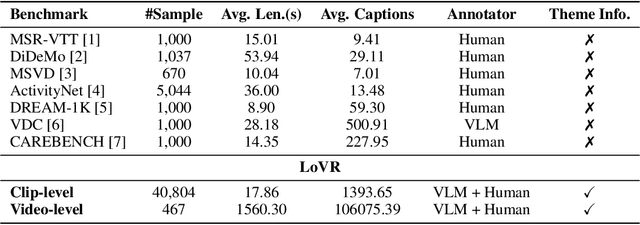

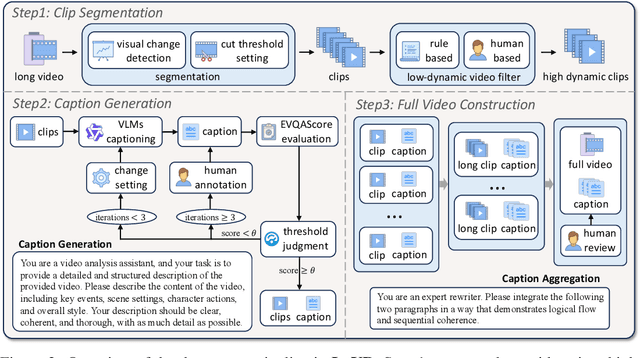
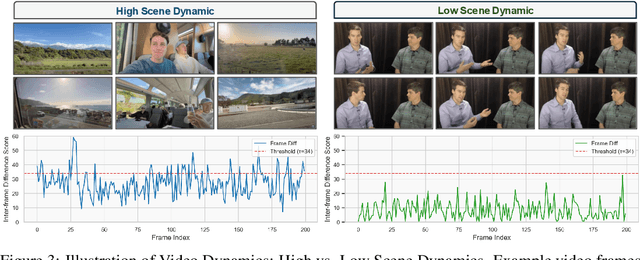
Abstract:Long videos contain a vast amount of information, making video-text retrieval an essential and challenging task in multimodal learning. However, existing benchmarks suffer from limited video duration, low-quality captions, and coarse annotation granularity, which hinder the evaluation of advanced video-text retrieval methods. To address these limitations, we introduce LoVR, a benchmark specifically designed for long video-text retrieval. LoVR contains 467 long videos and over 40,804 fine-grained clips with high-quality captions. To overcome the issue of poor machine-generated annotations, we propose an efficient caption generation framework that integrates VLM automatic generation, caption quality scoring, and dynamic refinement. This pipeline improves annotation accuracy while maintaining scalability. Furthermore, we introduce a semantic fusion method to generate coherent full-video captions without losing important contextual information. Our benchmark introduces longer videos, more detailed captions, and a larger-scale dataset, presenting new challenges for video understanding and retrieval. Extensive experiments on various advanced embedding models demonstrate that LoVR is a challenging benchmark, revealing the limitations of current approaches and providing valuable insights for future research. We release the code and dataset link at https://github.com/TechNomad-ds/LoVR-benchmark
 Add to Chrome
Add to Chrome Add to Firefox
Add to Firefox Add to Edge
Add to Edge